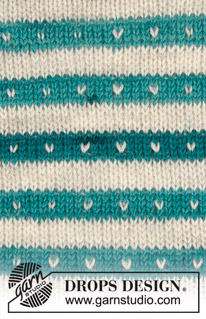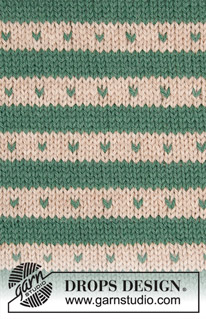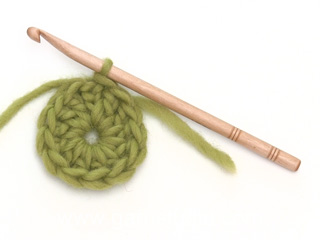Hello Stripes |
|||||||
 |
 |
||||||
Set of knitted jumper with stripes, dots and raglan, pants and socks for baby and children in DROPS Fabel
DROPS Baby 19-3 |
|||||||
|
JUMPER: PATTERN: See diagram M.1 and M.2. The entire pattern is worked in stocking st. DECREASING TIP (applies to raglan): FROM RS: At beg of row: 1 edge st, slip 1 st as if to K, K1, psso. At the end of row (beg when 3 sts remain): K2 tog, 1 edge st. By the other 3 markers dec as follows in each transition between sleeve and body piece (beg 3 sts before marker): K2 tog, K2 (marker sits between these 2 sts), slip 1 st as if to K, K1, psso. FROM WS: At beg of row: 1 edge st, P2 tog. At the end of row (beg when 3 sts remain): P2 tog into back of loop, 1 edge st. By the other 3 markers dec as follows in each transition between sleeve and body piece (beg 3 sts before marker): P2 tog into back of loop, P2 (marker sits between these 2 sts), P2 tog. NOTE! Make sure sts sit the right way as seen from RS. --------------------------------------------------------- --------------------------------------------------------- JUMPER: BODY PIECE: Worked in the round on circular needle. Cast on 140-156-176 (192-212) sts on circular needle size 2.5 mm with sea mist. K 1 round and continue in rib, K2/P2. When rib measures 4 cm K 1 round, AT THE SAME TIME dec 12-12-16 (16-20) sts evenly = 128-144-160 (176-192) sts. Insert a marker each side = 64-72-80 (88-96) sts between markers. Work M.1. After M.1 continue in M.2. REMEMBER THE KNITTING TENSION! When piece measures approx 17-18-21 (24-27) cm - adjust after 1 stripe in M.2 (i.e. after 5 rows in one colour) - work next round as follows: cast off 4 sts for armhole, work 57-65-73 (81-89) sts (= front piece), cast off 7 sts for armhole, work 57-65-73 (81-89) sts (= back piece) and cast off the last 3 sts for armhole, cut the thread. Insert a marker in the middle sts on back piece (= mid back at neck). Put piece aside and knit the sleeves. SLEEVE: Worked in the round on double pointed needles. Cast on 40-44-44 (48-52) sts on double pointed needles size 2.5 mm with sea mist. K 1 round and continue in rib, K2/P2. When rib measures 3 cm K 1 round, AT THE SAME TIME dec 4 sts evenly = 36-40-40 (44-48) sts. Insert a marker at beg of round = mid under sleeve. Continue in M.1. After M.1 continue in M.2. AT THE SAME TIME when piece measures 6 cm inc 1 st each side of marker. Repeat the inc on every 4-4-4 (5-6) round a total of 8-8-12 (12-12) times = 52-56-64 (68-72) sts – incorporate inc sts in pattern as you go along. When piece measures approx 16-17-20 (24-28) cm - adjust to the same row in M.2 as on body piece – cast off 7 sts mid under sleeve (= 4 sts after marker at beg of round and 3 sts before marker at the end of round) = 45-49-57 (61-65) sts left on needle. Cut the thread and put piece aside. Knit the other sleeve. YOKE: Slip sleeves on the same circular needle as body piece where cast off for armholes = 204-228-260 (284-308) sts. Insert a marker in all transitions between sleeves and body piece except by the left raglan at front (when jumper is worn). READ ALL OF THE FOLLOWING SECTION BEFORE CONTINUING! Continue back and forth on needle from the left raglan at front. Continue in M.2 - make sure stripes on sleeves and body piece match. Beg by casting off 3 sts at the beg of the next 2 rows (= raglan opening). RAGLAN DEC: Now dec 1 st with start from RS on each side of the 3 markers, at the same time dec 1 st at the beg and at the end of row (= 8 dec per row) – SEE DECREASING TIP! Repeat the dec on every other row a total of 10-12-11 (12-14) times and then on every row: 6-6-11 (12-12) times. After all dec are complete there are 70-78-78 (86-94) sts left on needle and piece measures approx 28-30-34 (38-42) cm from cast on row to the shoulder. Now work shortened rows mid back as follows from RS – continue in the last colour and work shortened rows in this colour: work row to marker mid back, work 6-7-7 (8-9) sts past marker and turn piece (to avoid a hole slip first st as if to K and tighten thread). Work 12-14-14 (16-18) sts and turn piece, work 18-21-21 (24-27) sts and turn piece, work 24-28-28 (32-36) sts and turn piece. Now slip all sts on a stitch holder and work the raglan edges before the neckline. RAGLAN EDGES: Pick up approx 24 to 32 sts (divisible by 4) inside 1 edge st along the raglan opening on sleeve on needle size 2.5 mm with sea mist. Work rib with 1 edge st in garter st and K2 each side as seen from RS. When the edge measures 2 cm cast off with K over K and P over P. Repeat along the raglan opening on front piece, but after 2 rows make 3 buttonholes evenly distributed (the last buttonhole is made on neckline). 1 BUTTONHOLE = cast off 2 sts and cast on 2 new sts on return row. NECK: Slip sts from stitch holder back on circular needle size 2.5 mm and pick up 5 sts on each front band with sea mist = 80-88-88 (96-104) sts. Work rib back and forth on needle from raglan opening as follows as seen from RS: 1 edge st in garter st, * K2/P2 *, repeat from *-* and finish with K2 and 1 edge st in garter st. AT THE SAME TIME after 2 rows make 1 buttonhole over the others on raglan edge. Cast off with K over K and P over P when neck measures 2 cm. ASSEMBLY: Sew openings under sleeves. Sew raglan edges tog at the bottom by opening towards the sleeve. Sew on buttons. ----------------------------------------------------------------- PANTS: PATTERN: See diagram M.1 – pattern worked in stocking st. DECREASING TIP: Dec as follows 3 sts before marker: K2 tog, K1. Dec as follows after marker: K1, slip 1 st as if to K, K1, psso. --------------------------------------------------------- --------------------------------------------------------- PANTS: Worked in the round on needle from bottom up. LEG: LOOSELY cast on 52-56-60 (64-68) sts on double pointed needles size 2.5 mm with sea mist. Insert a marker at beg of round = inside of leg. K 1 round and continue in rib, K2/P2 in the round for 5-5-6 (6-6) cm. K 1 round and continue in M.1. REMEMBER THE KNITTING TENSION! After M.1 continue in off-white and stocking st. AT THE SAME TIME on first round after M.1 inc 1 st on each side of marker. Repeat the inc on every 3-4-5 (8-12) round a total of 10-11-10 (9-8) times = 72-78-80 (82-84) sts. When piece measures 16-19-22 (27-33) cm (inc are now complete) divide piece on the inside of leg and complete piece back and forth on needle (to make it easier to slip both legs on the same circular needle afterwards). Cast on 1 new st each side for seam = 74-80-82 (84-86) sts. When piece measures 18-21-24 (29-35) cm cast off 3 sts at the beg of the next 2 rows with start from RS = 68-74-76 (78-80) sts. Put piece aside and knit the other leg. PANTS: Slip legs on the same circular needle size 2.5 mm = 136-148-152 (156-160) sts – beg of round = mid back. Insert a marker mid front. Continue in the round on needle with off-white and stocking st, AT THE SAME TIME dec 1 st on each side of marker mid front – SEE DECREASING TIP. Repeat the dec on every other round a total of 5-8-7 (6-5) times = 126-132-138 (144-150) sts. When piece measures 32-38-42 (48-55) cm adjust no of sts on round to 124-132-140 (144-152) sts. Now work shortened rows mid back as follows: Work 12 sts from beg of round, turn piece (to avoid a hole slip first st as if to K and tighten thread). Work 24 sts and turn piece, work 36 sts and turn, work 48 sts and turn. Continue like this by working 12 more sts before each turn another 6-6-6 (8-8) times. Now work M.1 on all sts, but work the pattern from top down in diagram. After M.1 continue in sea mist and stocking st. When piece measures 36-42-46 (52-59) cm work next round as follows: * K2 tog, 1 YO *, repeat from *-* (= folding edge). Work 2 cm stocking st and cast off loosely. ASSEMBLY: Sew tog split on the inside of each leg inside 1 edge st. Sew tog opening between legs. Fold the top towards WS along folding edge and fasten to WS but leave a small opening and insert the elastic. -------------------------------------------------------------------- SOCK: PATTERN: See diagram M.1 – pattern worked in stocking st. HEEL DECREASES: ROW 1 (= RS): Work row until 6-6-6 (7-8) sts remain, slip next st as if to K, K1, psso, turn piece. ROW 2 (= WS): Work row until 6-6-6 (7-8) sts remain, slip next st as if to P, P1, psso, turn piece. ROW 3 (= RS): Work row until 5-5-5 (6-7) sts remain, slip next st as if to K, K1, psso, turn piece. ROW 4 (= WS): Work row until 5-5-5 (6-7) sts remain, slip next st as if to P, P1, psso, turn piece. Continue dec like this with 1 less st before each dec until there are 8-10-10 (10-12) sts on needle. DECREASING TIP: Dec as follows before marker: K2 tog. Dec as follows after marker: Slip 1 st as if to K, K1, psso. --------------------------------------------------------- --------------------------------------------------------- SOCK: Cast on 48-52-52 (56-60) sts on double pointed needles size 2.5 mm with sea mist. Work rib, K2/P2 for 5-6-6 (7-7) cm. K 1 round, AT THE SAME TIME dec 12 sts evenly = 36-40-40 (44-48) sts. Continue in M.1. After M.1 continue in off-white and stocking st. When piece measures 7-8-8 (9-9) cm keep the first 18-20-20 (22-26) sts on needle for heel and slip the remaining 18-20-20 (22-22) sts on a stitch holder (= upper foot). Work stocking st back and forth on needle on heel sts for 3-3.5-4 (4-4.5) cm – insert 1 marker. Now work HEEL DECREASES – SEE ABOVE! After heel dec pick up 8-9-10 (10-11) sts each side of heel and slip sts from stitch holder back on needle = 42-48-50 (52-56) sts. Continue in the round in stocking st. AT THE SAME TIME on first round dec 1 st before the 18-20-20 (22-22) sts on upper foot by K2 tog, and dec 1 st after the 18-20-20 (22-22) sts on upper foot by slipping 1 st as if to K, K1 and psso. Repeat the dec on every other round a total of 3-6-7 (5-7) times = 36-36-36 (42-42) sts. Continue until sock measures 7-8-9 (10-12) cm from marker on heel, change to sea mist and continue in stocking st. When sock measures 8-9-10 (12-14) cm from marker on heel insert 1 new marker each side of piece (= 18-18-18 (21-21) sts on upper foot and under foot between markers). Now dec 1 st on each side of both markers – SEE DECREASING TIP. Repeat the dec on every round a total of 7-7-7 (8-8) times = 8-8-8 (10-10) sts left on needle. Cut the thread, pull it through remaining sts, tighten and fasten. Sock measures approx 10-11-12 (14-16) cm. |
|||||||
Diagram explanations |
|||||||
|
|||||||

|
|||||||

|
|||||||
|
Have you made this or any other of our designs? Tag your pictures in social media with #dropsdesign so we can see them! Do you need help with this pattern?You'll find tutorial videos, a Comments/Questions area and more by visiting the pattern on garnstudio.com. © 1982-2024 DROPS Design A/S. We reserve all rights. This document, including all its sub-sections, has copyrights. Read more about what you can do with our patterns at the bottom of each pattern on our site. |
|||||||









































































Comments / Questions (47)
Bei den Ärmeln steht "die neuen M. werden ins Muster eingestrickt", das verstehe ich nicht. Stricke ich mit den neuen Maschen das Muster einfach weiter? Dann verschiebt es sich ja, oder? Oder wie ist das zu verstehen? Danke!
18.07.2016 - 22:12DROPS Design answered:
Liebe Michaela, das Muster soll sich nicht verschieben, sondern die zugenommenen Maschen werden ins Muster integiert, also hinten angehängt oder vorne so gestrickt, dass es dann passend im Muster weitergeht.
19.07.2016 - 15:29Ist der Pullover nicht 3-farbig mit wechselnden Mustern? Hier sind nur 2 Farben mit einem Muster angegeben. Mit freundlichen Grüßen Ingeborg Schmidt
27.04.2016 - 10:55DROPS Design answered:
Liebe Ingeborg, die verschiedenen Farben, die Sie sehen kommen von dem mehrfarbigen Garn Fabel 910, sea mist.
28.04.2016 - 09:55Hallo, mir scheint die deutsche Übersetzung fehlerhaft. Denn bei den Tipps zur Abnahme fehlt die Angabe von zwei linken Maschen nach den zwei links verschränkt zusammengestrickten Maschen. Zwischen den beiden fehlenden Maschen müsste dann auch der Markierungsfaden liegen.
22.10.2015 - 11:13DROPS Design answered:
Sie haben Recht, das wird umgehend korrigiert, danke für den Hinweis und weiterhin gutes Gelingen!
30.10.2015 - 12:37Er dette en fejl? Jeg forstår ikke dette i opskriften til trøjen: Under afsnittet BÆRESTK står der, at man først skal tage ind på hveranden pind - det giver mening. Men derefter står der, at man skal tage ind på HVER pind. Eftersom man strikker frem og tilbage på dette stykke, betyder det jo, at der skal tages ind på vrangpinden. Er dette virkelig rigtigt? I givet fald passer det ikke med de de angivne indtagningstips.
24.06.2015 - 09:58DROPS Design answered:
Hej. Det er riktigt. Under "INTAGELSETIPS" har du förklaring både fra retsidan og vrangen. God fornøjelse!
24.06.2015 - 14:09Fabel Sea mist är ju mångfärgat!
28.04.2015 - 19:54I denne oppskriften og diagramforklaringen er kun oppgitt to garnfarger, men i genseren er det jo flere farger. Har jeg oversett noe, eller mangler det noe i oppskriften?
28.04.2015 - 18:57DROPS Design answered:
Hej Ruth. Fabel Sea Mist er mangefarvet - se ogsaa garnkortet her
29.04.2015 - 13:31Hei jeg har strikket en, nå på pinner andre genser, men annet farge :-)
15.04.2015 - 17:43Bukser: jeg lukker 2x3 masker på det første strikkede ben, når jeg strikker det andet skal de seks masker så lukkes fra vrangen eller akkurat som det første ben.
08.11.2014 - 17:03DROPS Design answered:
Hej Gitte, Det andet ben strikker du på nøjagtig samme måde. God fornøjelse!
25.11.2014 - 09:41Hei! Har laget genseren og er super fornøyd :) Jeg er i gang med buksene og har problemer med å forstå slutten av benet, hvor jeg skal felle 3 masker på to neste p med start fra retten. Totalt felle 6. Kan du utdype? Jeg forstår ikke når jeg skal felle. Ellers takk for supre oppskrifter!:)
13.09.2014 - 20:41DROPS Design answered:
Hej Kari, Du har delt arbejdet og strikker nu frem og tilbage fra indersiden af benet. Nu skal du lukke 3 m af i hver side af arbejdet (hvilket du gør i begyndelsen af de 2 næste pinde. Læg arb til side og strik det andet ben.
17.09.2014 - 08:30Co.lour 910 is "printed" = many-coloured
02.06.2014 - 13:21